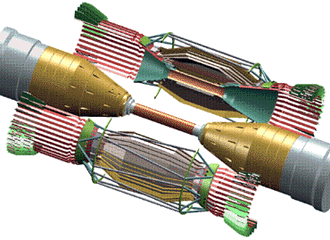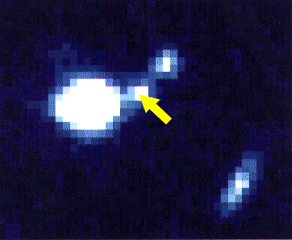





| 
| 
| 
| 
|

| The Silicon Vertex Tracker for the BaBar experiment at SLAC. The tracker will measure particle vertices with a precision of less than one-tenth of a millimeter, making it possible, for the first time, to study the phenomenon of CP violation, essential to our understanding of the nature of the Universe. |
 BaBar is closer to home, destined for the B-factory accelerator now being
assembled at the Stanford Linear Accelerator Center. This detector system is
being designed to measure the distance between the points of decay for the
subatomic particles known as B mesons and anti-B mesons. In the language of
particle physics these matter and antimatter particles are signified
"B/B-bar"-hence the naming of the detector after the familiar cartoon elephant.
The purpose of the BaBar detector is to study matter and antimatter differences,
particularly the phenomenon known as CP violation. Understanding CP violation
could answer another vexing question of science: Why, during the first
split-seconds of the Big Bang, did the process of creation favor matter over
antimatter?
BaBar is closer to home, destined for the B-factory accelerator now being
assembled at the Stanford Linear Accelerator Center. This detector system is
being designed to measure the distance between the points of decay for the
subatomic particles known as B mesons and anti-B mesons. In the language of
particle physics these matter and antimatter particles are signified
"B/B-bar"-hence the naming of the detector after the familiar cartoon elephant.
The purpose of the BaBar detector is to study matter and antimatter differences,
particularly the phenomenon known as CP violation. Understanding CP violation
could answer another vexing question of science: Why, during the first
split-seconds of the Big Bang, did the process of creation favor matter over
antimatter?
 Still another big scientific question now being tackled on a national and
international scale is "deceleration"-the rate at which the expansion of the
universe is slowing down. The answer lies in the stars, namely Type Ia
supernovas, the nuclear conflagrations that result from the implosion of a white
dwarf. Type Ia supernovas serve cosmologists as a measurement of distance and a
means of calculating the velocity at which galaxies are receding from Earth. It
is thought that analyzing the spectrums of about 50 type Ia supernovas will be
enough to determine the universe's rate of deceleration.
Still another big scientific question now being tackled on a national and
international scale is "deceleration"-the rate at which the expansion of the
universe is slowing down. The answer lies in the stars, namely Type Ia
supernovas, the nuclear conflagrations that result from the implosion of a white
dwarf. Type Ia supernovas serve cosmologists as a measurement of distance and a
means of calculating the velocity at which galaxies are receding from Earth. It
is thought that analyzing the spectrums of about 50 type Ia supernovas will be
enough to determine the universe's rate of deceleration.
 In December of this past year, a collaboration known as the Supernova
Cosmology Project (SCP), led by Berkeley Lab scientists, announced the discovery
of 11 new Type Ia supernovas, including several of the most distant stars ever
observed. These supernovas were discovered within a 48-hour period, an
unprecedented achievement that validated a Berkeley Lab technique developed to
make deep space supernova discoveries possible and eventually even routine. The
discoveries in 1995, combined with discoveries in 1993 and 1994, bring the total
of Type Ia supernovas identified by the SCP collaboration to 18.
In December of this past year, a collaboration known as the Supernova
Cosmology Project (SCP), led by Berkeley Lab scientists, announced the discovery
of 11 new Type Ia supernovas, including several of the most distant stars ever
observed. These supernovas were discovered within a 48-hour period, an
unprecedented achievement that validated a Berkeley Lab technique developed to
make deep space supernova discoveries possible and eventually even routine. The
discoveries in 1995, combined with discoveries in 1993 and 1994, bring the total
of Type Ia supernovas identified by the SCP collaboration to 18.

| One of the 11 new Type Ia supernovas discovered in December 1995 by researchers from the Supernova Cosmology Project, led by Berkeley Lab scientists. |
 Not only is the supernova project an example of a multi-institutional
collaboration spanning national borders and oceans, it also an example of
institutional cooperation. The Berkeley Lab scientists leading the project are
affiliated with both the Laboratory's Institute for Nuclear and Particle
Astrophysics, and the Center for Particle Astrophysics on the UC Berkeley campus.
Not only is the supernova project an example of a multi-institutional
collaboration spanning national borders and oceans, it also an example of
institutional cooperation. The Berkeley Lab scientists leading the project are
affiliated with both the Laboratory's Institute for Nuclear and Particle
Astrophysics, and the Center for Particle Astrophysics on the UC Berkeley campus.

| 
| 
| 
|